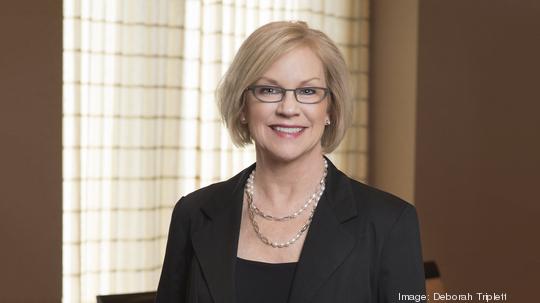
Local executive Cathy Bessant is not a classically trained technologist. Yet she worked her way through the ranks at Bank of America Corp., learning to lead in multiple lines of business, and became chief operations and technology officer in 2010.
Bessant started at BofA in 1982. She has held roles in corporate banking, product solutions, treasury services, real estate and marketing, among others. In her current role, Bessant leads the bank’s global technology and operations division, a team of roughly 95,000 employees across 35 countries.
Besides banking, Bessant is active in the community, partnering with UNC Charlotte, chairing the North Tryon Vision Plan Advisory Committee and, more recently, helping to launch the 2025 Charlotte-Mecklenburg Housing & Homelessness Strategy. In 2017, she received the Charlotte Business Journal’s Women in Business Lifetime Achievement Award.
Bessant is this year’s recipient of the CIO of the Year Awards’ Leadership ORBIE Award. She and others will be recognized at an awards event Sept. 10. Presented by CharlotteCIO, the program recognizes chief information officers and tech execs who have shown excellence in innovation, leadership, business value creation and community involvement. Twenty-three finalists have been selected across six categories. Winners are chosen based on an independent, peer-review process.
Bessant joins a list of distinguished Leadership ORBIE Award winners, including Angela Yochem at Novant Health, Cameron Faison at Charlotte Pipe and Foundry Co., Chuck Heck at Duke Energy Corp. and Craig Richardville at Carolinas HealthCare System, now Atrium Health.
Bessant recently talked with CBJ about how technology is affecting financial services, how BofA stays at the forefront of innovation and what factors into its decisions.
What role has technology played in the financial-services industry?
We have been on a constant automation and electronification journey for a long time, decades really. Wire transfers have been around for two generations at least, if not more. We’ve been automatically reading the MICR (magnetic ink character recognition) lines on checks for decades and doing ACH (automated clearinghouse) transactions (for) at least 20 years. The whole objective is to help make life easier for clients and customers. That’s really the purpose of the destination of innovation.
The last 18 months, there has been tremendous growth in our digital channels, exponential utilization, We’ve all been using electronic channels, no matter what we’re undertaking and everybody has been doing that a lot more. People always ask me, “How do we drive digital demand or digital adoption?” I think we’re way past that in financial services. It’s our job now to keep up with digital demand. The goal has to be to be able to deliver our full capabilities anywhere and anytime our clients and customers want them. That requires us to be brilliant at digital technology.
Bank of America has long been on the forefront of technology. Has the pandemic led to increased urgency or accelerated innovation?
We’ve definitely been on a fast pace of innovation in 2020, despite what everybody thought might happen. We applied for and were issued more patents than any other year in our history. ... We are constantly working with clients and customers to understand what features are important to them, what insights are important to them and how we can deliver those digitally. I would say the pace has changed in terms of making sure that our digital channels offer customers everything that they want, with the full understanding that their expectations for quality of service and full availability have never been higher.
Does the bank view technology differently than it did pre-Covid?
We have changed quite a bit our thinking about technological tools for employees, collaboration tools, accessibility. Having worked remotely for a long period of time means that, over time, a simple conference call doesn’t work for every single thing that we’re trying to do. The demands for fully available service and network capacity at all times became suddenly very high. Adapting to all of those needs for better tools and increased capacity does require us to think differently.
We’ve created a new role at Bank of America that we call our chief information officer for employee (experience). ... The reason we did that is so that we’d think about the applications of technology — how we think about the integration of technology across all of our various lines of business, people that work in our lines of business, how they can communicate with each other, how they can share and collaborate. If I had to put a term to it, I think in the past we’ve always thought of employees as the place where we should be as efficient as possible, meaning as low cost as possible in our employee tools. It only makes sense. But I think today, the needs of our employees and the demand of our talent in the workforce mean that we don’t just have to be efficient, we have to be the best and we’re working to get there.
How does the bank stay ahead on innovation?
We’ve got a long-established leadership team who are best in the industry in their individual capabilities. We’ve got our top 1,000 managers in (Global Technology & Operations). We get together frequently via virtual channels and talk about what we’re doing and how to stay on top of things. It’s about having great talent and then communicating constantly about the vision for what we’re after. The great thing about technologists is … that their DNA is fundamentally creative, to attack an opportunity or to attack a problem and to use technology to cause even our employee experience to be great. You don’t have to push a technologist too hard to stay on the forefront of things.
How do you track down the talent you need for these technology jobs?
There are always certain key areas where we want to keep accessing senior talent. That said, we are very focused on hiring internally. Two years ago, for our job openings at all levels, we would be hiring at about 39% internally. Today, that percentage is over 80%, and that’s by design. We don’t need more people. We need the people we have to be well-skilled for our needs today and into the future. One thing that’s great about financial services is, because this has been a constant innovation, automation, electronification journey, we are used to and pretty experienced at making sure that technological change is a good thing for our employees. For example, we have GT&O University, which is specifically dedicated to helping people re-skill, acquire new skills, sharpen existing skills, to be eligible for roles that we have open.
How do you attract the talent that you do have to acquire?
We have a great brand and a brand that’s known for excellence in technology. The bank’s Responsible Growth strategy, led by our CEO and Chairman Brian Moynihan, resonates even with the youngest people, who believe that being a great corporate citizen and being profitable have to go hand in hand. You can’t have one without the other.
Second, we have a world-class set of compensation and benefits packages that help us attract people. In a world where people have rediscovered what work-life balance means to them or how they want to balance community and commerce, that ecosystem of compensation and fair wages and great benefits is really important in the attraction process as well. The other thing in these spaces is that great talent gets great talent. People want to work for our leaders, and they come because we have a very special group of leaders.
How do you make continued investments into your talent?
We do talent planning twice a year to make sure that we’re continually expanding and promoting our people. We work really hard to improve diversity in the disciplines where that diversity is not what we want it to be. Tech is a place where there aren’t enough women, there aren’t enough people of color, and we work really hard to ensure that our development and promotional efforts encourage a diverse workforce at all levels. We’re investing in our talent all the time.
Has the increased focus on tech brought different people to the table when BofA makes decisions?
I don’t think that it brought new or different people to the table. I think it’s given the people that are at the table the requirement of new skill sets. ... You can’t run a really large business unless you understand how technology works and the possibilities that technology might have to change your business strategy. I would say it has broadened the skill sets of the people at the table, more so than it maybe brought different people to the table.
How does BofA view technology as a factor in making decisions?
It’s always a factor to consider — just like risk, just like revenue, just like customer need and customer satisfaction. It’s a consideration. How would we support this from a technical perspective? What do we need to build to make sure that the platform performs appropriately? All of those factors are a part of decision-making processes.
What are some lessons you’ve learned as a technology leader, especially during the pandemic?
I think the importance of empathy — really being able to see things through other people’s eyes, your boss’ eyes, your peers’ eyes, your employees’ eyes, your customers’ eyes — when you can’t see those things face-to-face. I think all leaders have been required to sharpen their skills on empathy. I think we’ve also had to really, as leaders, learn about speed. If you have 200,000 people and you have to figure out in three days how they can all work from home, that’s a completely different kind of speed than is normal for a typical corporation.
One of the big (lessons) is about risk. Leaders have always evaluated risk in part based on probability. ... Well, probability has been thrown out the window because there isn’t anybody who thought that a global pandemic was even a medium probability. So, reframing how we think about risk, not from what could happen to what if it happens. That is a very big deal, and good leaders are making that switch.
What’s next for technology in financial services?
Universal infrastructure is important, so investing to have 5G technology enabled all over the country and all over the world is incredibly important. The technology is not new, but its availability is not universal. It’s less about new technology than it is about the application and the deployment of those technologies. The exception I would make there of course is cyber, because as cyber criminals continue to get more innovative — and that’s the job of criminals, to be innovative — we have to deploy technologies in new ways every day to make sure that we stay ahead of that trend.





